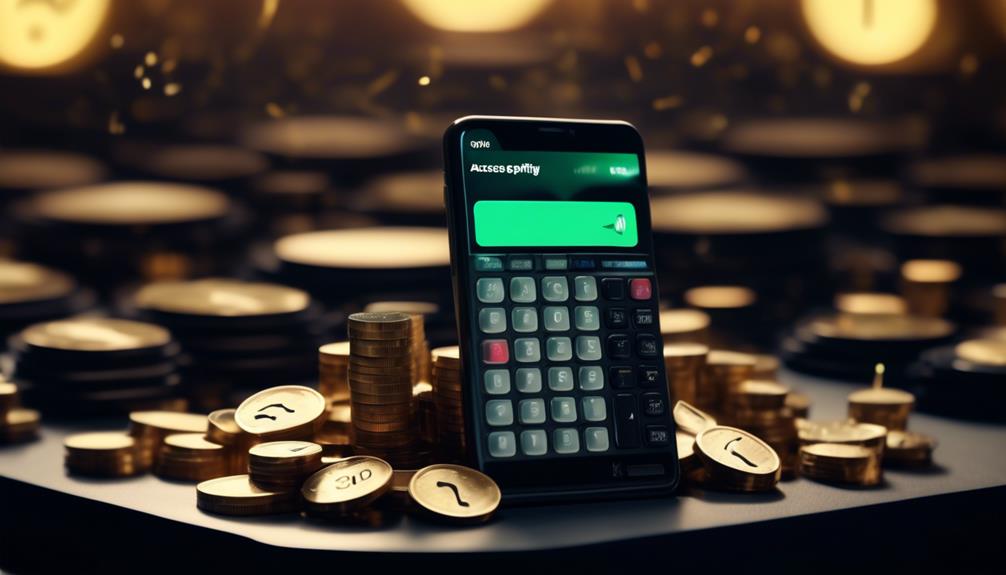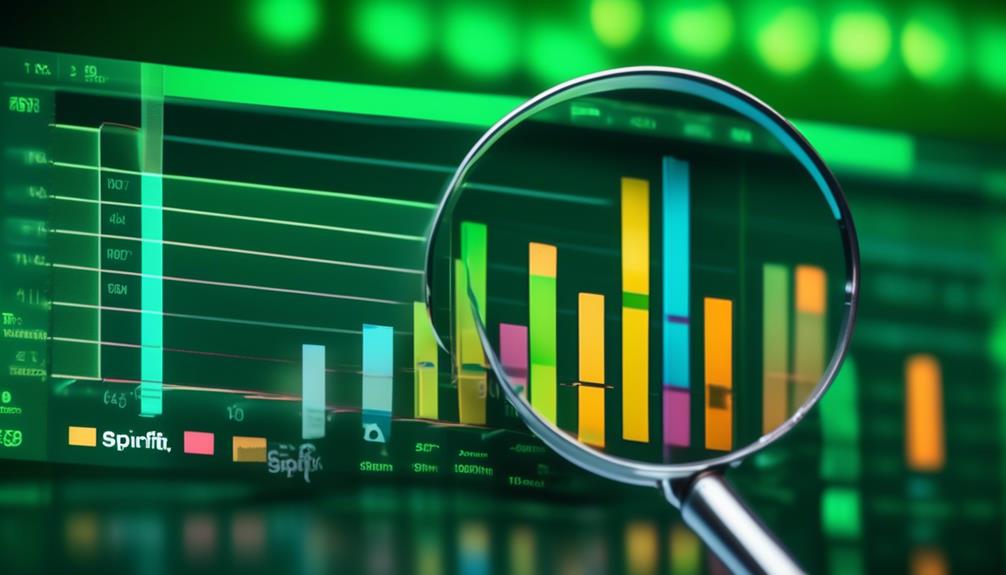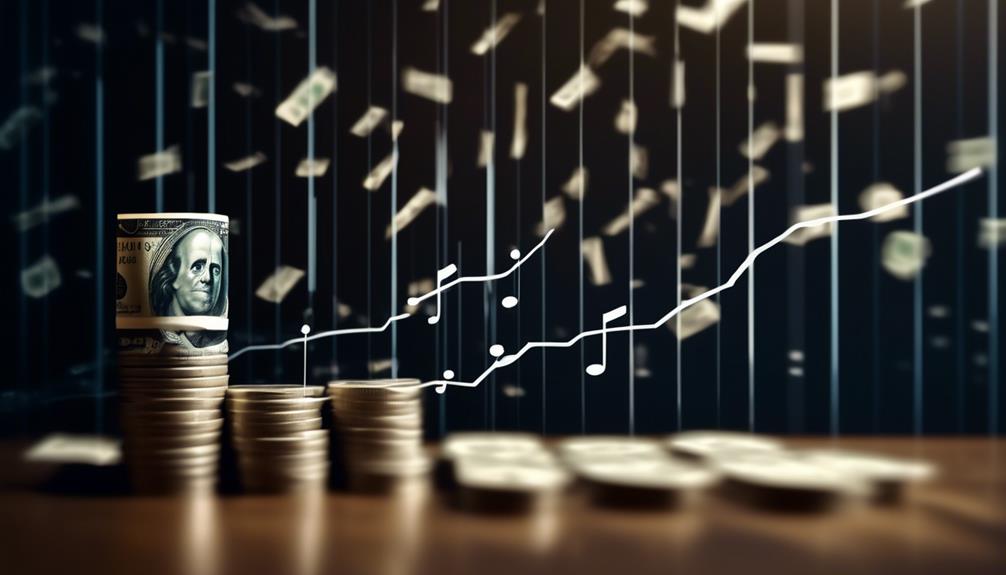
How much is Spotify royalties for 1,000 streams?
Imagine you’ve just crafted the most ear-catching tune in the history of music and it’s garnered a sweet 1,000 streams on Spotify – congratulations!
But, you’re probably wondering, what’s the financial reward for this viral success?
Well, Spotify’s royalty payout isn’t as straightforward as you might think. There’s a complex formula influenced by numerous factors, such as the listener’s subscription type and your country’s royalty rates.
So, how much can you expect to pocket from this streaming milestone?
We’re about to unravel this financial mystery, stick with us, you’ll want to know the answer.
Key Takeaways
- Spotify’s payment structure for royalties is complex and takes into account factors such as user type, exclusive content deals, and distribution agreements.
- Listener location plays a significant role in determining royalties, with higher payouts in countries where Spotify has a larger user base.
- Understanding the factors that influence earnings per stream on Spotify, such as stream rates and the platform’s royalty formula, is crucial for artists to maximize their earnings.
- Technology can bring transparency to royalty distribution and pave the way for a fairer music streaming landscape.
Understanding Spotify’s Payment Structure

Diving into Spotify’s payment structure, you’ll find it’s a complex system that intricately calculates royalties based on a multitude of factors. This isn’t a one-size-fits-all scheme; it’s an inventory of variables that affect how much an artist earns per stream.
One such influential factor is the ‘Subscriber tiers impact’. Spotify’s subscribers aren’t all on the same level – there are free users and there are premium users. The type of user listening to a song affects the payout. Generally, streams from premium users generate more revenue because they’re directly paying for the service.
This system may seem convoluted, but it’s designed to fairly distribute the subscription and ad revenue among artists, based on their share of total streams.
Also, you can’t overlook the ‘Exclusive content benefits’. Spotify often works out deals for exclusive rights to certain albums or songs. These exclusives usually have a higher payout rate, which benefits the artist. It’s a strategic move on Spotify’s part that attracts more subscribers, and thus more revenue.
Factors Influencing Spotify Royalties
You might’ve noticed that Spotify royalties can vary significantly. The factors behind this include how Spotify calculates these royalties and the impact of the listener’s location.
Let’s investigate these elements to better understand how they shape what artists earn per stream.
Spotify’s Royalty Calculation
In understanding the calculation of Spotify royalties, it’s crucial to consider several factors that significantly influence the final payout for 1,000 streams. Issues like royalty disputes and streaming transparency can greatly affect your earnings.
Spotify uses an algorithm that takes into account your total number of streams relative to all streams on the platform. This percentage is then multiplied by Spotify’s total payout for that month.
Your geographical location, agreement with your distributor, and the listener’s subscription type also play a part.
It’s important to note that these factors can fluctuate, making the royalty calculation complex and dynamic.
In this ever-evolving digital music landscape, staying informed about these factors will help you navigate and maximize your Spotify earnings.
Impact of Listener’s Location
Beyond the realm of raw stream numbers, the location of your listeners can significantly sway your Spotify royalties, a factor often overlooked by artists and producers. Geographical disparities and the listening habits of different regions can influence your earnings.
Consider these three points:
- Market Value: Royalties are higher in countries where Spotify’s market value is greater. For instance, streams from the U.S. or Europe tend to pay more than those from Asia or Africa.
- User Base: The larger the Spotify user base in a country, the greater your potential reach and, in turn, your royalties.
- Listening Habits: Countries with more avid listeners who stream regularly can increase your revenues.
Understanding these factors can help you strategize your music promotion for maximum impact and profit.
Calculating Earnings per Stream

To calculate your earnings per stream on Spotify, you’ll need to understand stream rates and the platform’s royalty formula.
Stream rates can fluctuate based on several factors, such as your audience’s location and the type of subscription they have.
Once you’ve grasped these variables, you can apply them to Spotify’s royalty formula to estimate your potential earnings.
Understanding Stream Rates
Diving into the realm of stream rates, you’ll find that calculating your earnings per stream isn’t as straightforward as it may initially seem. Factors such as stream demographics and royalty negotiations play crucial roles.
- Stream Demographics: Your earnings can vary based on the listener’s location and subscription type. Streams from premium users typically yield higher payouts.
- Royalty Negotiations: Your contract with Spotify influences your earnings. Labels and rights holders often negotiate different rates.
- Pool Distribution: Spotify employs a pro-rata model, distributing royalties based on an artist’s share of total streams.
In essence, understanding stream rates is a multidimensional process that requires a keen analytical eye. It’s a dynamic ecosystem, constantly evolving in response to market trends and user behaviors.
Spotify’s Royalty Formula
Having grasped the intricacies of stream rates, let’s now unravel the complexity of Spotify’s royalty formula, a key determinant of how much you earn per stream. Notably, royalty disparities exist, largely influenced by user subscriptions. Spotify’s formula takes into account the listener’s country, whether they’re a free or premium user, and the artist’s relative popularity.
In essence, Spotify divides the total revenue, less operational costs, among all streamed tracks. Therefore, if your song has a higher share of total streams, you earn more. But here’s the catch: premium user streams generate more royalties than free user streams. So, even if your song gets a million streams, the payout varies depending on who’s listening. Understanding this formula helps you gauge potential earnings and strategize accordingly.
Average Royalty Rates on Spotify
On average, you’ll find that Spotify pays about $0.003 to $0.005 per stream in royalties, a rate that may seem small, but can add up significantly with a large volume of streams. However, it’s crucial to understand that these are average figures, and there are several factors that can impact the exact amount an artist earns.
One of the key factors is royalty discrepancies, which can occur due to variations in listener location, subscription type, and the artist’s individual agreement with Spotify. For example, streams from premium subscribers tend to generate higher royalties than those from free users.
- Listener Location: Royalties can vary depending on whether the listener is based in a high- or low-income country.
- Subscription Type: Premium subscribers contribute more to royalties compared to free users.
- Artist Agreement: The terms of an artist’s contract with Spotify can significantly affect the royalty rate.
Another consideration is the profitability of various genres. Some genres are more popular on Spotify and thus attract more streams, leading to greater royalty earnings. Therefore, understanding these dynamics can help you maximize your potential earnings on Spotify.
Demystifying Spotify’s Royalty Distribution

Building on the understanding of Spotify’s average royalty rates, it’s essential to unpack how the platform distributes these royalties, a process often shrouded in complexity. The streaming giant employs a pro-rata model, where the total subscription and advertising revenue is pooled, then distributed based on the proportion of total streams. This method, while efficient, has raised questions about royalty transparency.
You may wonder, ‘Does each stream have the same value?’ The answer is no. The value of a stream is influenced by the listener’s country, subscription type, and the artist’s agreement with their record label or distributor. It’s a dynamic ecosystem, fraught with variables that can affect the final payout.
There’s been a growing call for artist advocacy, pushing Spotify to consider a user-centric payment system. This model would ensure artists are paid directly based on their listeners’ streaming habits, giving independent and niche genres a fighting chance.
Innovative solutions are required to address these complexities. Technology can play a pivotal role in illuminating the path towards a fairer, more transparent royalty distribution. It’s a challenge that needs to be faced head-on, paving the way for a more equitable music streaming landscape.
Case Study: Artist’s Earnings Breakdown
To fully grasp the intricacies of Spotify’s royalty distribution, let’s delve into a real-world scenario detailing an artist’s earnings breakdown. Suppose you’re an indie artist, and your latest hit racks up 1,000 plays.
Now let’s dissect your earnings:
- Spotify’s average payout per stream ranges between $0.003 and $0.005. So, expect around $3 to $5 for those 1,000 streams.
- If you’re under a label, they’ll take a cut. Commonly, labels take 50-70% of royalties, leaving you with $1.50 to $2.50.
- Deduct other costs like production, promotion, and management fees, and you’re left with even less.
This shines a light on an essential aspect of modern music business: Artist’s revenue diversification. You can’t rely solely on streaming income. Merchandise, live shows, licensing for movies or ads – these are crucial income streams for artists today.
And here’s where the ‘Independent vs. Label artists’ debate comes in. As an indie artist, you keep all your royalties, but the promotional muscle of a label might amplify your streams significantly. It’s a trade-off you’ll need to consider carefully.
The landscape is complex, but with the right strategy, you can navigate it successfully.
Tips to Increase Spotify Royalties

Boosting your Spotify royalties might seem like a daunting task, but with a strategic approach and a clear understanding of the platform’s algorithm, you’ve got more control than you think. Promoting playlists effectively is a key factor in this. It’s essential to actively share your playlists on social media platforms and engage with your listeners. A well-curated playlist can draw in more listeners, leading to increased streams and, in turn, higher royalties.
Collaborating with artists is another effective strategy. By featuring other artists in your playlists or working on tracks together, you can tap into their fan base and increase your exposure. This can potentially raise your stream count drastically, boosting your royalties.
While implementing these strategies can increase your streams and royalties, it’s equally crucial to have a firm grasp of Spotify’s royalty policies to maximize your earnings effectively. Spotify’s royalty policies can seem complex, but with a clear understanding and careful navigation, you can leverage them to your advantage.
- Royalty Calculations: Spotify uses a pro-rata model, which means royalties are distributed based on the percentage of total streams your music garners. Understand this model to estimate potential earnings accurately.
- Royalty Negotiations: Spotify enters contractual agreements with labels and distributors. If you’re independent, you’ll negotiate with distributors who deliver your music to Spotify. These negotiations directly impact your royalty rate, so ensure you’re involved and informed.
- Monthly Listener Base: Spotify’s royalty payouts also depend on the number of active monthly listeners. The more listeners you have, the larger your share of the royalty pie.

